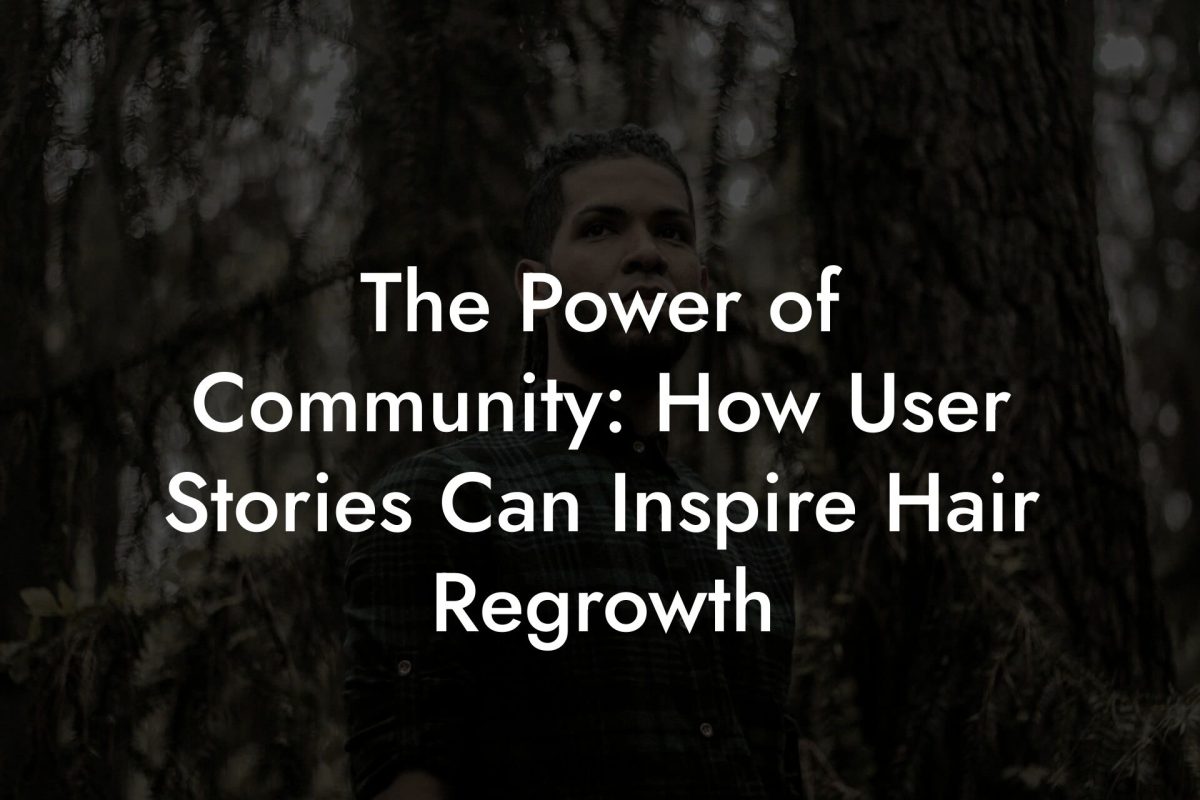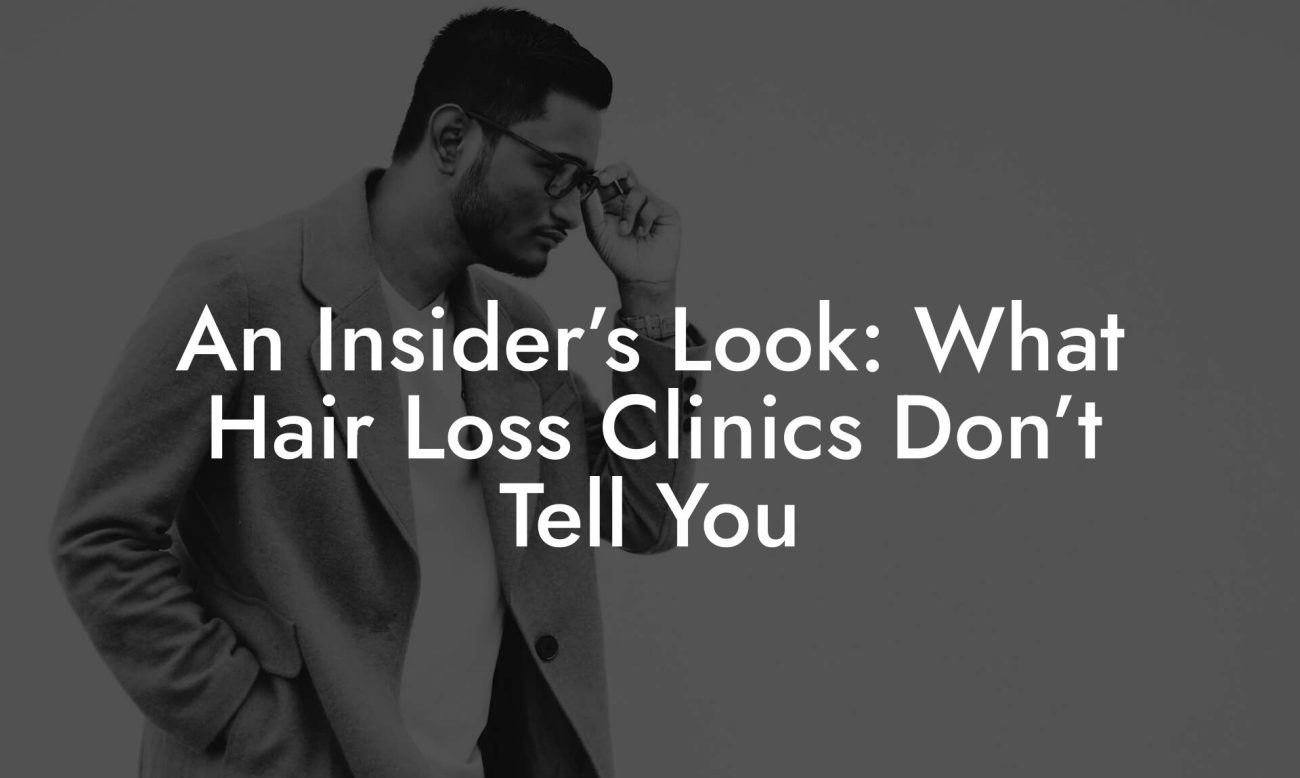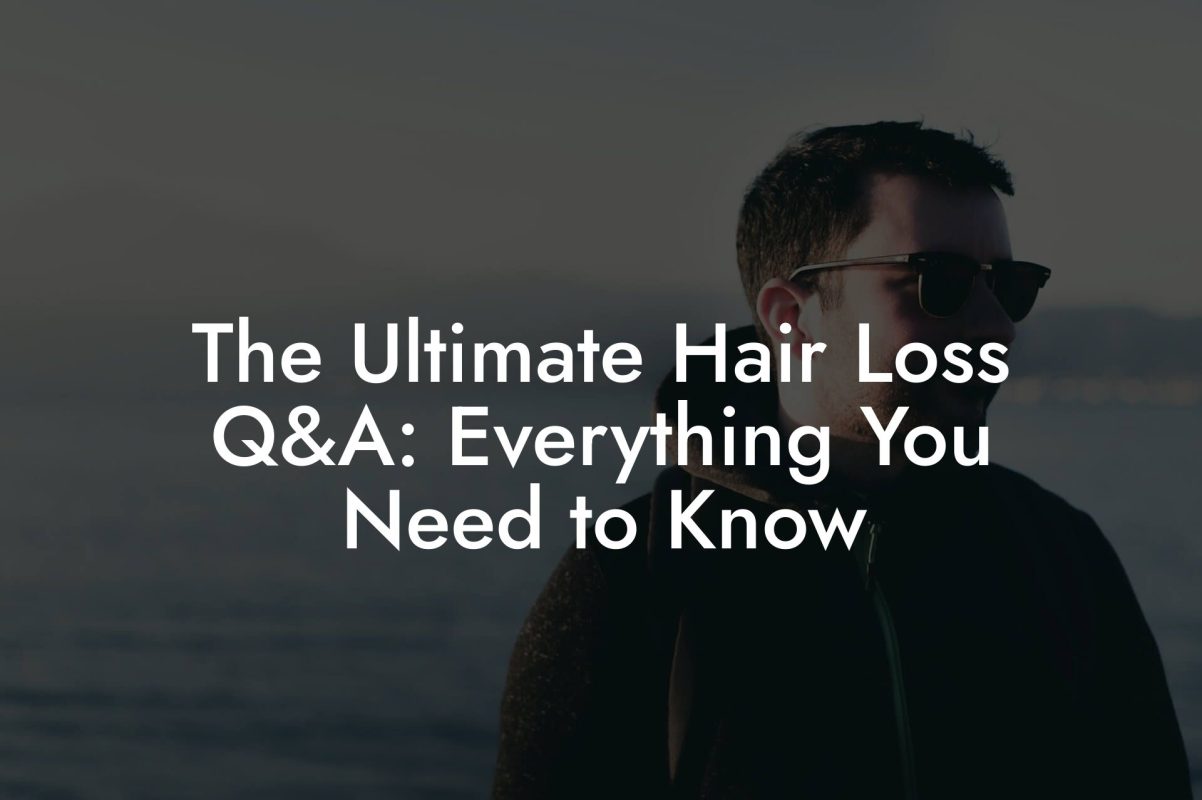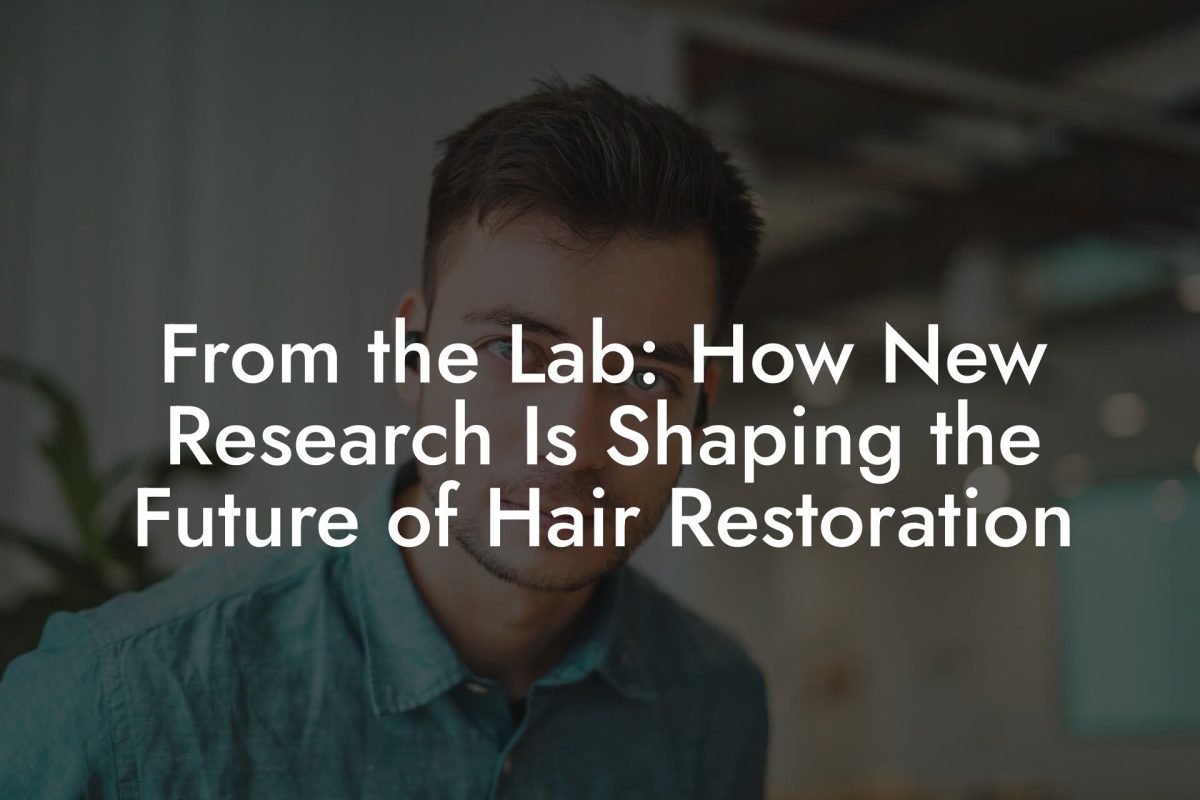Hair Loss Library
Hair Loss in Different Age Groups: What the Experts Recommend

Ever catch your reflection and think, “Wait a minute, is that a receding hairline or a modern art installation?” Welcome to the Mane Matrix—your friendly guide through the labyrinth of hair loss, tailored for the bold, curious, and style-savvy millennial and Gen Z gentleman. Whether you're just beginning to notice a peculiar thinning in the crown area or you're lamenting the mysteries of your grandfather’s infamous bald patch, this definitive guide breaks down hair loss across different age groups with expert-backed insights, witty banter, and a whole lot of relatability.
Understanding Hair Loss: Causes, Myths, and What’s Really Going On
Hair loss isn’t just a phenomenon reserved for those who’ve reached “vintage” status; it’s a multifaceted condition that can start to rear its head even when you’re still vibing with the latest meme trends. From genetics and hormones to stress and lifestyle choices, numerous factors choreograph the dance of disappearing hair. Forget the outdated myths that blame your lack of a miracle shampoo or your inability to meditate—today’s scientific conquests reveal a complex interplay of factors.
Key culprits include androgenetic alopecia (the fancy term for male pattern baldness), telogen effluvium (that shock-induced shedding after a big life event), and even conditions like alopecia areata. Experts advise looking at the bigger picture: diet, stress management, and, yes, even your sleep patterns can affect your hair’s vitality. Plus, let’s not downplay the impact of modern life—between an endless scroll of social media and the offbeat pressures of urban living, your follicles are exposed to more than just the elements.
The science is in, and the experts are clear: understanding the underlying causes is the first step in reclaiming control over your mane. So, buckle up as we journey through the phases of life, pinpointing what happens to your hair—and how to counteract those ever-potent forces of nature and lifestyle.
Youthful Tresses Under Pressure: Hair Loss in Your Teens and Early Twenties
In the days when you were still figuring out your favorite meme and debating the merits of avocado toast, you might not have given much thought to your hair. But here’s the twist: even in your late teens and early twenties, a surprising number of dudes face early-onset hair loss. While the media often sidelines this topic to older generations, research shows that younger men can experience thinning or patchy hair scenarios, often due to genetics, hormonal fluctuations, or even high stress levels that come with college life and first jobs.
Experts emphasize that early intervention is key. Don’t worry—this isn’t a “doom and gloom” forecast. Many cases of youthful hair loss are temporary or manageable with lifestyle adjustments and early treatments. Consider it a wake-up call: your hair might just be signaling the need for a healthier routine overall. Supplementing your diet with vital nutrients, managing stress through habits like meditation or even a good Netflix binge (in moderation), and being mindful of your hair care routine can make a world of difference.
Embracing the reality of hair loss at a young age isn’t about resigning to fate; it’s about taking proactive steps with a sense of humor and style. When your buddies joke about “forehead expansion,” you can laugh along while also nodding to the science behind those receding lines. Early-stage solutions can be as simple as switching to mild shampoos, avoiding harsh styling products, and even consulting with a hair restoration expert who understands your generation’s need for quick, unobtrusive advice.
The Roaring 20s and 30s: When Hair Loss Trends Begin to Emerge
Welcome to the prime of your life—when your career is budding, your social calendar is packed, and yes, sometimes your hair starts playing hide and seek. In your 20s and 30s, many men notice that their hairline might not be behaving as it used to. And while a few stray hairs can be chalked up to a shift in style (hello, trendy buzz cut!), a pronounced receding line could be a sign of androgenetic alopecia paving the way.
Experts in hair restoration are quick to point out that this is the period where preventative measures can work wonders. Think of it as investing in a “hair health portfolio” early on. Routines incorporating specialized shampoos enriched with ingredients like biotin, saw palmetto, and caffeine have gained traction—backed by promising studies and testimonials. Don't be surprised if you find yourself browsing through forums discussing the latest hair growth serums or laser combs that promise to turn back the clock on thinning hair.
Being in your 20s and 30s is all about experimentation and self-expression. If you feel a little self-conscious about your hair thinning around the temples, consider it an opportunity: explore stylish cuts, experiment with textured styles, or even rock a well-groomed stubble. Embracing your hair journey with confidence isn’t just about looking good—it’s about feeling empowered and taking control of your personal style narrative.
Meanwhile, experts recommend establishing practices that support long-term hair health. Incorporating a balanced diet rich in vitamins, regularly exercising to stimulate healthy blood circulation, and minimizing stress through hobbies you love are all integral to keeping your mane vibrant. Trust the process—it might just be the best investment you make in your self-confidence.
The 40s, 50s, and Beyond: Strategies for the Seasoned Gentleman
As you gracefully transition into your 40s and beyond, your hair tells a story—one of lived experiences, challenges overcome, and style refined over the years. Yet, it might also start to whisper hints of thinning as you embrace the evolution of your body. Male pattern baldness, or androgenetic alopecia, often becomes more pronounced during these decades, but there’s no need to panic. Instead, consider these changes as part of your signature look, while also exploring modern treatments that can help maintain volume and density.
In this stage of life, expert recommendations focus on both cosmetic solutions and medically backed treatments. Over-the-counter options like minoxidil have been game-changers for many, while prescription medications such as finasteride offer more targeted interventions. But it doesn’t stop there—innovative procedures like platelet-rich plasma (PRP) therapy and low-level laser therapy (LLLT) bring high-tech solutions into play, combining science and style in a sleek, modern package.
Beyond the products and procedures, the seasoned gentleman is advised to maintain a holistic mindset. That means balancing any hair restoration efforts with robust lifestyle changes that support overall well-being, like a nutrient-rich diet and regular exercise. Remember, your hair might be one part of your identity, but the confidence you exude comes from a well-cultivated sense of self-awareness and humor.
Today’s experts are in agreement: Your 40s and 50s can be a time of reinvention. Customize your approach to hair care to match your evolving style—be it a refined cut that embraces the natural progression of hair loss or advanced treatments that revive your confidence. This isn’t about chasing eternal youth; it’s about celebrating life’s phases with savvy, science-backed decisions.
Expert Recommendations: Tailoring Treatments for Every Age
So, what’s the ultimate game plan across all these age groups? The experts suggest a tailored approach that adapts to your current phase of life, lifestyle, and even genetic predispositions. Let’s break down some of the key recommendations that have been turning heads (and hair strands) in the world of hair restoration:
- Prevention and Early Intervention: According to specialists, starting preventive care early—especially in your teens and 20s—can delay the progression of hair loss. Consider regular care routines and consult with professionals at the first signs of thinning.
- Medical Treatments: From over-the-counter solutions like minoxidil to prescription medicines such as finasteride, these treatments backed by clinical research have shown remarkable results in slowing down hair loss and stimulating new growth.
- Procedural Innovations: If you’re ready to take a more aggressive stance, options like PRP therapy, laser treatments, and even hair transplant surgeries provide a roadmap to reclaiming that full head of hair.
- Lifestyle Adjustments: Never underestimate the power of a balanced diet, regular exercise, and stress management. Foods rich in vitamins A, C, D, E, and minerals like zinc and iron are known allies in the fight against hair loss.
- Personalized Hair Care Routines: Modern hair care isn’t one-size-fits-all. Tailor your shampoo, conditioner, and styling regimen based on your hair type and the specific challenges you’re facing.
With these recommendations in hand, picture your hair care journey as a personalized roadmap—one that evolves with each stage of your life. Whether you’re experimenting with new treatments or simply tweaking your daily routine, remember that the goal is not just to preserve your hair, but to feel confident, bold, and unapologetically you.
Lifestyle & Nutrition: Fueling a Future of Healthy Hair
Great hair doesn’t just grow; it’s nurtured by a lifestyle that supports overall well-being. Think of your body as a high-performance machine—what you fuel it with makes all the difference. The experts agree that a well-balanced diet rich in vitamins, lean proteins, and antioxidants isn’t just good for your health in general; it’s a game changer for your hair.
For instance, omega-3 fatty acids found in fish oil, walnuts, and chia seeds help reduce inflammation and promote scalp health. Vitamin D and biotin are often highlighted as essential co-factors for healthy hair growth, while iron and zinc work behind the scenes to ensure your follicles get the nutrients they need. And let’s not forget hydration—a well-hydrated scalp is a happy scalp.
Beyond the food group, incorporating regular exercise into your routine helps improve blood circulation, delivering more nutrients to your hair follicles. And while it might sound cliché, managing stress is paramount. In the age of social media overload, it’s easy to spiral into anxiety, which can further impact hair health. Whether it’s through mindfulness practices, a quick gym session, or just an honest chat with a friend, every little bit helps.
The bottom line? Think of your overall health as the fertile soil for your hair to grow. Nurture your body, and your hair will reward you with vitality and resilience.
The Psychological & Social Impact of Hair Loss
Let’s talk real talk—the emotional roller coaster of hair loss can be as significant as the physical experience. For many men, especially in an age obsessed with image and self-expression, hair is more than just strands on your head; it’s a symbol of identity, youth, and confidence.
Studies have shown that hair loss can lead to feelings of anxiety, depression, and diminished self-esteem. But here’s the silver lining: open conversations are breaking down the stigma surrounding male hair loss. Comedy roasts, celeb confessions, and an ever-growing community of men sharing their journeys online have all contributed to a fresh narrative—this is not the end, but a new beginning in the evolution of your style.
Experts encourage those experiencing hair loss to connect with communities and mental health professionals who understand the emotional weight behind each strand. The conversation is shifting from “What’s wrong with my hair?” to “How can I work with what I’ve got, and maybe even make it a signature brand?” Embrace the journey with humor and authenticity—after all, confidence comes from owning your story.
Modern Treatments & Innovations in Hair Restoration
Luckily, the era of “trial and error” is coming to an end. With innovations in technology and fresh insights from today’s leading experts, hair restoration is more effective and accessible than ever. Let’s explore some of the hottest modern treatments making waves in the world of hair loss:
Medicated Shampoos & Topical Solutions
Medicated shampoos featuring ingredients like ketoconazole, caffeine, and saw palmetto have evolved from mere scouring agents to active participants in hair restoration. They help reduce scalp inflammation, block DHT (the hormone tightly linked to male pattern baldness), and promote a healthier environment for hair growth.
Platelet-Rich Plasma (PRP) Therapy
PRP therapy might sound like something out of a sci-fi flick, but it’s very real and surprisingly effective. By using your body’s own platelets to stimulate hair follicles, this minimally invasive treatment encourages growth and thickening. Many men report noticeable improvements after a series of sessions, making this a compelling option to consider.
Low-Level Laser Therapy (LLLT)
Imagine a futuristic hair salon where lasers are harnessed to stimulate hair growth. Low-level laser therapy devices, available as combs or helmets, use illuminated beams to activate cellular metabolism in the scalp. Research supports their use in revitalizing thinning hair, and it’s becoming a favorite among tech-savvy individuals who appreciate at-home treatments.
Surgical Hair Restoration
For those looking for a more permanent solution, surgical options like hair transplants remain a trusted method to recapture a fuller hairline. These procedures have advanced remarkably, offering natural-looking results while drastically reducing recovery times.
While these treatments can seem high-tech, experts advise a personalized consultation to determine the best option based on your age, severity of hair loss, and overall health. Innovation meets individualization in modern hair restoration—tailoring solutions to ensure you not only look great but feel confident about your next chapter.
DIY and Natural Approaches: At-Home Regimens to Spark Growth
Not everyone is ready to jump into the high-tech world of PRP or laser therapy—and that’s totally fine. Sometimes, a few natural tweaks at home can go a long way in boosting hair health. For the eco-friendly and budget-conscious, there are plenty of natural remedies and DIY regimens to consider.
Many experts advocate for a holistic approach to hair care that includes natural oils, herbal treatments, and scalp massages. Try massaging your scalp with coconut oil, rosemary oil, or even olive oil to stimulate blood flow. Incorporating biotin-rich foods (like eggs and nuts) into your diet can also help boost hair strength from the inside out.
Natural treatments are best seen as part of a broader lifestyle strategy. Combine these at-home techniques with good sleep hygiene, regular exercise, and stress management practices, and you’ll create a nurturing environment for your hair to flourish. After all, your hair is just one facet of a vibrant, dynamic you.
Resources and Community Support: Your Next Steps
Navigating the world of hair loss can feel like wandering through a maze, but you don’t have to do it alone. The internet is awash with supportive communities, expert advice, and inspiring transformation stories that can help you chart your course to a healthier head of hair.
Start by following trusted platforms like Mane Matrix, where real experts break down the complexities of hair loss without the intimidation of clinical jargon. Join forums, social media groups, or even local meet-ups dedicated to discussing male hair loss and restoration. Engaging with others who share your journey can provide both practical tips and a much-needed boost of confidence.
It’s also smart to check out our recommended reading lists, product reviews, and expert interviews to stay up-to-date with the latest trends in hair restoration. Many resources now offer a blend of humor, science, and personal insight that makes even the most daunting aspects of hair loss approachable.
Whether you’re considering a visit to a specialist or simply want to arm yourself with knowledge, remember that every step you take is progress. The road to confident hair health is paved with community, education, and a little bit of self-love.
FAQ: Frequently Asked Questions About Hair Loss in Different Age Groups
We’ve gathered some of the burning questions about male hair loss and compiled clear, expert-backed answers to help you better understand your hair journey.
1. What are the most common causes of hair loss in men?
The leading causes include androgenetic alopecia (male pattern baldness), stress, poor diet, hormonal imbalances, and certain medical conditions. Genetics also play a huge role, determining how susceptible you are to these factors.
2. Can lifestyle changes really make a difference in hair health?
Absolutely. Regular exercise, a balanced diet rich in vitamins and minerals, adequate sleep, and effective stress management can all positively impact hair growth and overall scalp health.
3. Is early hair loss a sign of future balding?
Not necessarily. While early thinning can be a precursor to more extensive hair loss, many men slow down or even stabilize their condition with early intervention and proper care.
4. What treatment options are recommended for men in their 20s and 30s?
For younger men, experts often recommend preventive measures including medicated shampoos, topical solutions like minoxidil, and lifestyle adjustments. Early consultation with a hair loss specialist can also tailor treatments to your specific needs.
5. How effective are modern hair restoration treatments?
Innovations like PRP therapy, laser treatments, and surgical transplants have shown significant success. The effectiveness often depends on early intervention, the severity of hair loss, and consistent care.
6. Are natural remedies and DIY approaches worth trying?
Yes. Natural remedies such as scalp massages, essential oils, and a biotin-rich diet can complement medical treatments and help foster a healthy scalp environment.
7. How do I know which treatment is right for me?
Consultation with a hair loss specialist is key. They can assess your specific situation, conduct tests if necessary, and recommend a personalized treatment plan that aligns with your lifestyle and needs.
8. Is stress really linked to hair loss?
Yes, high stress levels can trigger a type of hair loss called telogen effluvium, which causes more hairs than usual to enter the resting phase. Managing stress is thus essential for maintaining hair health.
9. What role does diet play in preventing hair loss?
A nutrient-dense diet that includes ample proteins, vitamins, and minerals is crucial for hair growth. Foods high in antioxidants and omega-3 fatty acids can help maintain scalp health and promote follicle strength.
10. Can I treat hair loss at home without professional help?
Many men see improvements with at-home care routines that incorporate proper nutrition, natural remedies, and medically recommended products. However, if hair loss is significant or rapidly progressing, professional consultation is advised.
Your Journey to Empowered Hair Health
Embracing your hair’s journey is more than a battle against the receding line—it’s an opportunity to redefine your style, boost your confidence, and celebrate the wisdom that comes with every stage of life. The Mane Matrix journey isn’t about a magic cure; it’s about being proactive, informed, and unapologetically you.
Whether you’re just noticing the first signs of hair thinning or have already embraced the sleek look of a well-groomed style, take heart in the fact that every step you take is supported by expert insights and modern innovations. From early interventions in your teens and 20s to advanced treatments in later years, your approach to hair loss can be as dynamic as your personality.
This guide has equipped you with the knowledge to make confident decisions, engage with supportive communities, and explore tailored treatments that evolve with you. Enjoy the journey—it’s a blend of science, style, and a healthy dose of humor that reminds you: true confidence is not just about having a full head of hair, but owning your unique path.
So, stand tall (and maybe tilt that stylish cap just right), knowing that every strand, every receding line, and every breakthrough in hair restoration is part of the story of you. Here’s to redefining the narrative of hair loss and walking into your next chapter with vigor, innovation, and a spirit that’s as resilient as your determination to look and feel great.
If you loved this article... Dive deeper into the world of mens hair loss with our most popular sections. If there is anything you think is missing or anything you would love for us to write about, just give us a shout.
Expert Interview: Leading Dermatologists Discuss Men’s Hair Loss Solutions
Case Study: How One Man Reversed His Hair Loss Naturally
Hair Loss FAQs: Your Top Questions Answered by Experts
Behind the Scenes: A Day in the Life of a Hair Transplant Surgeon
Success Stories: Real Men Share Their Hair Regrowth Journeys
Debunking Hair Loss Myths: Insights from Top Trichologists
The Role of Genetics: Experts Weigh in on Inherited Hair Loss
How Lifestyle Changes Made a Difference: Inspiring Hair Regrowth Stories
In-Depth Q&A: What Every Man Should Ask Before a Hair Transplant
Roundtable: Experts Debate the Best Non-Surgical Hair Loss Treatments
From the Lab: How New Research Is Shaping the Future of Hair Restoration
Personal Journeys: Overcoming Hair Loss and Embracing Confidence
The Ultimate Hair Loss Q&A: Everything You Need to Know
An Insider’s Look: What Hair Loss Clinics Don’t Tell You
Expert Tips for Maximizing Hair Restoration Treatment Results
Hair Loss in Different Age Groups: What the Experts Recommend
Addressing Scalp Concerns: A Comprehensive FAQ for Men
Analyzing Competitor Gaps: How Mane Matrix Stands Out in Hair Loss Content
The Power of Community: How User Stories Can Inspire Hair Regrowth
Future Forecast: What Experts Predict for Men’s Hair Loss Treatments
















